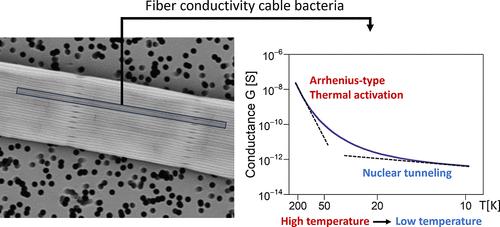Our official English website, www.x-mol.net, welcomes your
feedback! (Note: you will need to create a separate account there.)
Temperature-Dependent Characterization of Long-Range Conduction in Conductive Protein Fibers of Cable Bacteria
ACS Nano ( IF 15.8 ) Pub Date : 2024-11-12 , DOI: 10.1021/acsnano.4c12186 Jasper R. van der Veen, Silvia Hidalgo Martinez, Albert Wieland, Matteo De Pellegrin, Rick Verweij, Yaroslav M. Blanter, Herre S. J. van der Zant, Filip J. R. Meysman
ACS Nano ( IF 15.8 ) Pub Date : 2024-11-12 , DOI: 10.1021/acsnano.4c12186 Jasper R. van der Veen, Silvia Hidalgo Martinez, Albert Wieland, Matteo De Pellegrin, Rick Verweij, Yaroslav M. Blanter, Herre S. J. van der Zant, Filip J. R. Meysman

|
Multicellular cable bacteria display an exceptional form of biological conduction, channeling electric currents across centimeter distances through a regular network of protein fibers embedded in the cell envelope. The fiber conductivity is among the highest recorded for biomaterials, but the underlying mechanism of electron transport remains elusive. Here, we performed detailed characterization of the conductance from room temperature down to liquid helium temperature to attain insight into the mechanism of long-range conduction. A consistent behavior is seen within and across individual filaments. The conductance near room temperature reveals thermally activated behavior, yet with a low activation energy. At cryogenic temperatures, the conductance at moderate electric fields becomes virtually independent of temperature, suggesting that quantum vibrations couple to the charge transport through nuclear tunneling. Our data support an incoherent multistep hopping model within parallel conduction channels with a low activation energy and high transfer efficiency between hopping sites. This model explains the capacity of cable bacteria to transport electrons across centimeter-scale distances, thus illustrating how electric currents can be guided through extremely long supramolecular protein structures.
中文翻译:

电缆细菌导电蛋白纤维长距离传导的温度依赖性表征
多细胞电缆细菌表现出一种特殊的生物传导形式,通过嵌入细胞包膜的规则蛋白质纤维网络将电流引导到厘米距离内。纤维电导率是生物材料中记录最高的之一,但电子传输的潜在机制仍然难以捉摸。在这里,我们对从室温到液氦温度的电导进行了详细的表征,以深入了解长距离传导的机制。在单个细丝内部和之间可以看到一致的行为。接近室温的电导揭示了热激活行为,但活化能较低。在低温下,中等电场下的电导几乎与温度无关,这表明量子振动通过核隧穿耦合到电荷传输。我们的数据支持并联传导通道内的不相干多步跳跃模型,具有低活化能和高跳跃位点之间的高传递效率。该模型解释了电缆细菌跨厘米级距离传输电子的能力,从而说明了电流如何通过极长的超分子蛋白质结构。
更新日期:2024-11-13
中文翻译:

电缆细菌导电蛋白纤维长距离传导的温度依赖性表征
多细胞电缆细菌表现出一种特殊的生物传导形式,通过嵌入细胞包膜的规则蛋白质纤维网络将电流引导到厘米距离内。纤维电导率是生物材料中记录最高的之一,但电子传输的潜在机制仍然难以捉摸。在这里,我们对从室温到液氦温度的电导进行了详细的表征,以深入了解长距离传导的机制。在单个细丝内部和之间可以看到一致的行为。接近室温的电导揭示了热激活行为,但活化能较低。在低温下,中等电场下的电导几乎与温度无关,这表明量子振动通过核隧穿耦合到电荷传输。我们的数据支持并联传导通道内的不相干多步跳跃模型,具有低活化能和高跳跃位点之间的高传递效率。该模型解释了电缆细菌跨厘米级距离传输电子的能力,从而说明了电流如何通过极长的超分子蛋白质结构。


















































 京公网安备 11010802027423号
京公网安备 11010802027423号